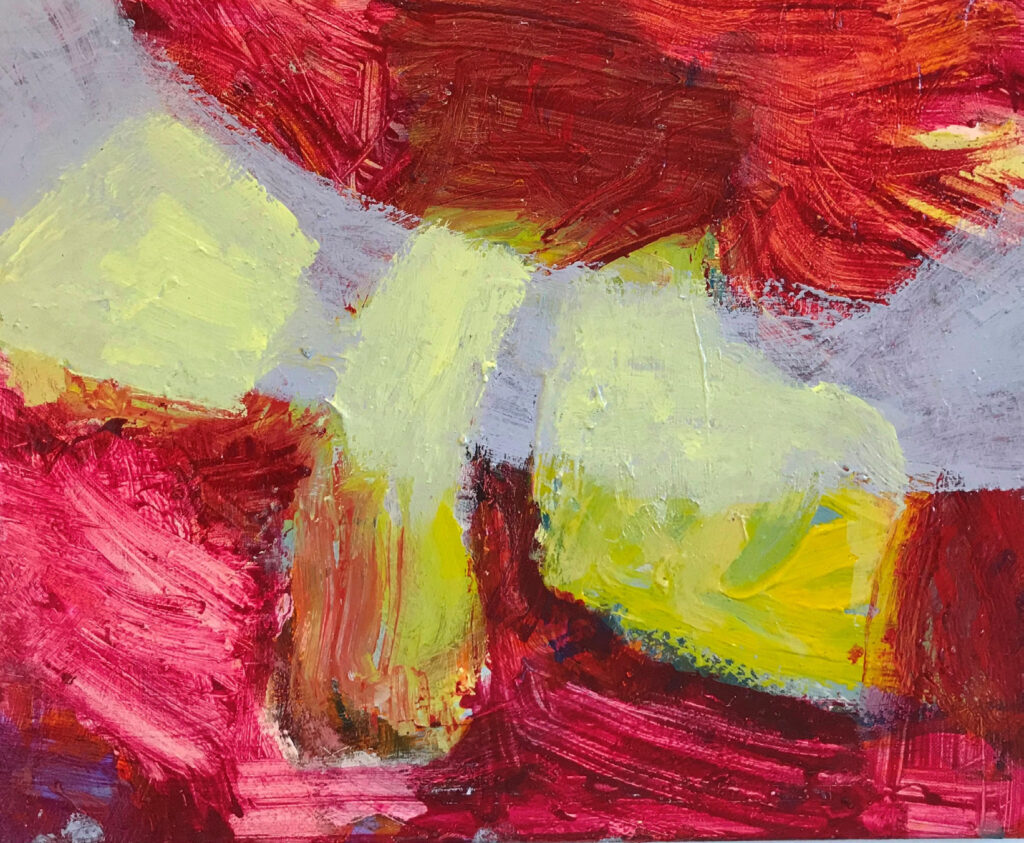With three solid walls and a façade of glass, this little gallery already has a lightbox quality, and with the unabashedly polychrome paintings of Paul Behnke and Bill Page, the first impression is one of a rich and ebullient wave of color. A similarity in palette is the underlying premise of pairing these two artists in this show curated by artist William Norton, and it’s a firm base from which to start. They employ a range of strong colors positioned against complementary or opposing colors so as to create firm boundaries. These are not indistinct fields but considered zones, and the commonality between the two artists is the use of color as the main dynamo of form—after this initial unified statement, Behnke and Page move in their own unique directions.

All of the paintings in “On the Road” are of a humble size: Page offers the viewer abstract glimpses and momentary visual thoughts of his beloved cathedral of Guanajuato in central Mexico, while Behnke’s canvasses, painted in Taos NM, are larger but still refrain from attempting to overwhelm the viewer. Behnke’s paintings invite the viewer to follow his train of thought. In Horus (2021), he begins by drawing us into a pair of lung shaped forms, one black, the other pink. From these, a network of light green lines expand and draw the eye to smaller pools of color, most notably yellow forms and lines, and into the dull, and looming Prussian blue background. Camazotz (2021), on the other hand, plays with the illusion of depth. A precipitously curving slope of morose gray holds the foreground while a punchy cadmium red is used for the background, creating a jarring truncated picture plane. In the middle Behnke constructs a vibrating structure of color, with blues, reds, pinks and greens, popping like crazy, but with the same gray and cadmium as well, offering a consistent optical path from the front to the back.
Page’s paintings, unlike Behnke’s, are hung from the ceiling on down, to where they rest on the floor and lean against the wall. The effect is that of a kind of Proustian flood of memories. His subject is a colonial baroque cathedral, and his project seems to follow the path of the impressionists and postimpressionists, catching light as it transforms the architectural details of the cathedral. The cupolas, pediments, and architraves have all been abstracted out of recognizability, replaced by simple comparisons of color. Because they emerge from studies and sketches of the movement of light and shadow, and the transitions from morning to twilight across a complex form, they have an anchor in the real, which comes through. Page’s horizontal work (all are titled Cathedral of Guanajuato (2021), depicting three irregular pale yellow forms against a mottled brown and scarlet background, seems to show a transit of some kind—either of light moving across a sculptural form, or the sparkling highlights from a stained glass window. The artist emphasizes the movement through a ghostly swath of pale gray.

While both artists seem transfixed by the colors they summon up from their travels in various dry regions (Behnke, the desert, and Page, the mountains), the streams of thought which emerge from these pools of inspiration seem to go in diametrically opposed directions in “On the Road.” Unlike the fantastical, sometimes figural forms of Behnke, Page’s theme is ambiguity; a close-up of something which we can never fully comprehend in its totality. G&S
paulbehnke.net – billpagepaintings.com – nortonartists.com/#/on-the-road





Leave a Comment